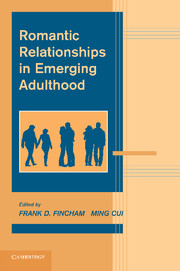Book contents
- Frontmatter
- Contents
- List of Contributors
- Foreword
- PART I INTRODUCTION
- PART II CONCEPTUAL AND METHODOLOGICAL FOUNDATIONS
- 2 Romantic Relationships in Emerging Adulthood: Conceptual Foundations
- 3 Relationship Sequences and Trajectories: Women's Family Formation Pathways in Emerging Adulthood
- 4 Models of Change and Continuity in Romantic Experiences
- 5 Working With Dyadic Data in Studies of Emerging Adulthood: Specific Recommendations, General Advice, and Practical Tips
- PART III THE DEVELOPMENTAL CONTEXT OF ROMANTIC RELATIONSHIPS IN EMERGING ADULTHOOD
- PART IV RELATIONSHIP PROCESSES IN EMERGING ADULTHOOD
- PART V PRACTICAL IMPLICATIONS
- Index
- References
3 - Relationship Sequences and Trajectories: Women's Family Formation Pathways in Emerging Adulthood
Published online by Cambridge University Press: 06 December 2010
- Frontmatter
- Contents
- List of Contributors
- Foreword
- PART I INTRODUCTION
- PART II CONCEPTUAL AND METHODOLOGICAL FOUNDATIONS
- 2 Romantic Relationships in Emerging Adulthood: Conceptual Foundations
- 3 Relationship Sequences and Trajectories: Women's Family Formation Pathways in Emerging Adulthood
- 4 Models of Change and Continuity in Romantic Experiences
- 5 Working With Dyadic Data in Studies of Emerging Adulthood: Specific Recommendations, General Advice, and Practical Tips
- PART III THE DEVELOPMENTAL CONTEXT OF ROMANTIC RELATIONSHIPS IN EMERGING ADULTHOOD
- PART IV RELATIONSHIP PROCESSES IN EMERGING ADULTHOOD
- PART V PRACTICAL IMPLICATIONS
- Index
- References
Summary
Jeffrey Arnett has argued that emerging adulthood has become a distinct stage in the life course for people between the ages of 18 and 25 (Arnett, 2000). This stage is characterized by independence from major social roles and commitments, such as marriage, childbearing, and establishing a career. Instead of “settling down,” emerging adults use this time to sample a variety of life experiences and engage in a prolonged process of self-exploration. Arnett saw the emergence of this stage in the life course in a mostly positive light – as a period during which young people formulate coherent and meaningful identities with respect to love, work, and worldviews. Arnett recognized that not all young people have the resources to experience a period of independence and exploration. Nevertheless, a tendency exists in much of the written work on this topic to assume that emerging adulthood has become a stage in the life course for the majority of youth.
I begin this chapter by examining the notion of emerging adulthood from a historical perspective. The second half of this chapter explores an alternative approach to stage theories of youth development. I adopt a life course perspective and focus on the multiple and divergent pathways that young women take between the ages of 18 and 23.
- Type
- Chapter
- Information
- Romantic Relationships in Emerging Adulthood , pp. 27 - 43Publisher: Cambridge University PressPrint publication year: 2010



